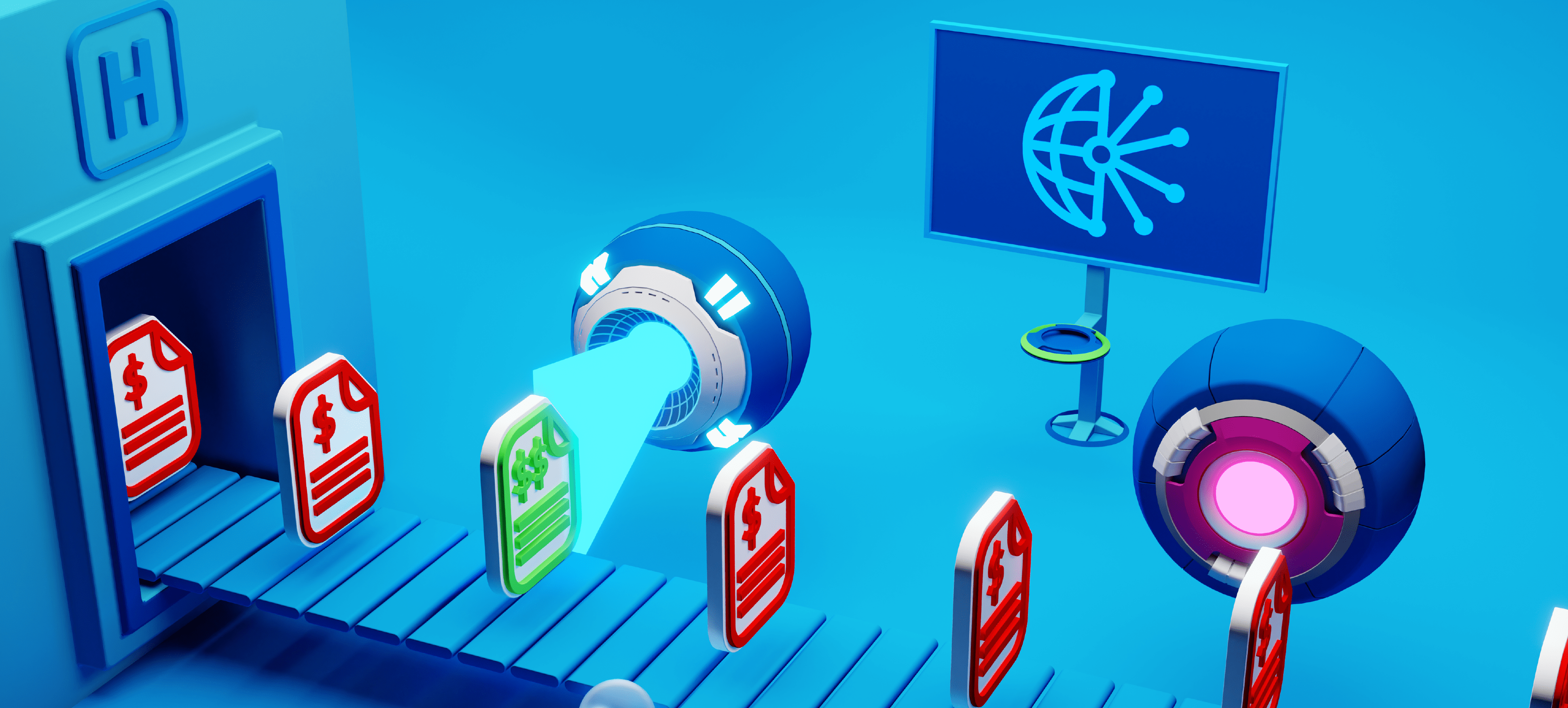All posts by Kelly Nguyen

When it comes to healthcare, patient access is the top priority for most individuals. When patients are surveyed on what they value most, timely access to their doctor rises to the top. Experian Health's State of Patient Access 2023 survey found that patient satisfaction hinges on efficient scheduling. Many believe that patient access has improved in recent times due to the ability to book appointments more quickly. On the contrary, those who think otherwise attribute slow booking systems to the decline in accessibility. However, delivering a high-quality patient intake experience isn't always straightforward. Meeting the needs of an aging population – many of whom are managing multiple chronic conditions – is an increasing challenge in the context of ongoing shortages of clinical and administrative staff. With financial performance dependent on attracting and retaining both patients and staff, balancing supply and demand in patient access is a high-stakes equation for providers. Breaking down the key opportunities and challenges can help providers identify appropriate strategies for optimization. Specifically, what role can digital patient access services play in ensuring patients get the care they need when they need it? What is patient access, and why is it critical to the patient experience? Patient access is the cornerstone of the healthcare system. It encompasses the systems and strategies that make or break a patient's access to care. Can they find a suitable provider in their area? How easy is it to book appointments and register for care? Can they understand and pay their bills without too much difficulty? While logistical elements such as geographic location and transportation certainly factor into how easily a patient can get care, patient access tends to focus on the administrative processes involved in scheduling and registration, verifying insurance coverage, appointment management, patient billing and payments, and patient communications. If these services are clunky, slow and disjointed, healthcare providers will fail to deliver high-quality and timely care to those who need it. Top key performance indicators (KPIs) for patient access services Getting patient access right can improve patient outcomes, increase patient satisfaction and reduce healthcare costs over time. But quality is often subjective. What should providers seek when striving for “high-quality” patient access? Common metrics might include: Wait times for appointments, diagnostic tests and procedures Speed and accuracy of the appointment scheduling process Percentage of patient access-related inquiries resolved on first contact No-show rates, which might indicate communication or scheduling issues Efficiency and accuracy of insurance verification, coding and billing Revenue collected before or at the point of service Staff performance and productivity Tracking these metrics can help providers find new ways to optimize patient access services. How to improve patient access services (and why) Monitoring and improving these KPIs is easier with digital and data-driven systems. But the benefits of digital patient access services go far beyond efficient data reporting. Offering patients online, digital and self-service options for scheduling, pre-registration and payments leads to a better patient experience while improving operational efficiency. Improved patient experience Alex Harwitz, Vice President of Product, Digital Front Door, at Experian Health, explains that “For patients, the digital front door results in more convenience, choice and control over their patient access experience. For example, online self-scheduling streamlines the appointment process, so patients can schedule, reschedule, or cancel appointments whenever it is convenient for them, which is often outside provider office hours. We can make sure they're only shown available appointments with the right specialist, and then send them helpful reminders so they're less likely to miss the appointment.” He says, “Digital systems can simplify the booking process for patients with complex medical needs. By incorporating automated scheduling protocols and business rules, navigating specialist appointments becomes more streamlined.” Similarly, digital pre-registration means patients can complete paperwork from home, where they have access to their medical records and insurance information. Tools like Registration Accelerator can pre-fill much of this data, saving time and preventing errors. Patient portals and secure messaging platforms also allow patients to communicate directly with their providers safely and easily. They can seek advice and clarify doubts, fostering a stronger patient-provider relationship. Increased operational efficiency Many providers have hesitated to turn to automation in lieu of human staffing, but implementing automation yields immediate and significant benefits. This includes reduced manual labor, improved workflows and communication, and increased profitability. Self-service tools like Patient Scheduling Software and Registration Accelerator reduce the administrative overhead, so staff can focus on critical tasks that need a human touch. In Experian Heath's survey, 36% of providers said these types of technological improvements have helped to offset staff shortages. By incorporating accurate data from patients' medical records, there's also less risk of data entry errors, which speeds up downstream services and reimbursement. Digital patient access software can also generate performance reports, to drive further operational improvements against the KPIs listed above. What are the main obstacles in implementing patient access solutions? Implementing patient access software may seem daunting due to resource limitations, outdated technology, and cost concerns. However, with the increasing demand for remote access to digital services, healthcare providers cannot delay any longer. Fortunately, those who have already taken the initiative are experiencing a significant long-term return on investment that outweighs the initial costs. For more complex challenges, a trusted third-party partner can help guide the way. Lack of standardized policies Patient pricing estimates are an essential piece of the patient access experience. However, insurance and reimbursement policies are constantly changing and vary by payer, so delivering accurate estimates is a tough ask. Many hospitals have struggled to comply with new federal price transparency rules. With Patient Payment Estimates, patients can be given an accurate, personalized breakdown of their financial responsibility, sent directly to their phone. Research by Experian Health and PYMNTS suggests that such tools can boost patient satisfaction by 88% and reduce the risk of missed payments. To help providers comply with broader requirements around price transparency, Experian Health has joined forces with Cleverley + Associates to offer a standardized solution. Interoperability and integration with existing systems The lack of compatibility between electronic health records and hospital management software can result in significant errors in patient information. These inaccuracies can lead to miscommunications with patients and payers, as well as delays in providing care and missed opportunities for reimbursement. To avoid this, providers should choose automated patient access tools that integrate with their existing systems. For example, Experian Health clients that already use eCare Next® can integrate additional patient access solutions, such as Eligibility Verification, through the same interface. There's no need for staff to access multiple systems and patient intake is much faster. Comprehensive data analytics give a better overview of operational performance. Safeguarding privacy and data security are also easier with integrated solutions from a single vendor. The future of patient access solutions in healthcare Rapid technological advancements, evolving policies, and changing patient expectations can make the future of healthcare hard to predict. However, certain patient access trends look set to continue: Patients will increasingly seek out easy-to-use digital platforms for accessing and paying for care, especially as younger generations age and increase their utilization of healthcare services. Patients will increasingly seek personalized care – extending to tailored patient access experiences that reflect individual needs and communication preferences. The use of data analytics and AI will grow exponentially across healthcare services, helping providers identify patterns and automate workflows. Digital patient access services have become an integral part of the healthcare landscape as providers recognize their role in improving patient outcomes and overall business success. In today's healthcare landscape, these services are essential elements to success. Find out more about how Experian Health's patient access solutions can help providers improve patient satisfaction, increase operational efficiency, and future-proof their revenue cycle for years to come.

According to Experian Health's State of Patient Access 2023 survey, providers think recent efforts to improve the patient financial experience are paying off. But do patients agree? The survey, carried out in December 2022, suggests a disconnect between how patients and providers view the patient collections process. Many providers rate their collections services favorably, having invested in pre-service estimates, flexible payment options and tailored payment plans. However, patients see room for improvement and a chance for providers to improve patient collections. Many say they feel anxious about managing medical expenses, with uncertainty prompting some to consider canceling care or switching providers. Could a more compassionate and personalized approach to healthcare billing help patients navigate their financial obligations more easily? Here are 4 ways providers can improve patient collections and create a patient experience that attracts long-term loyalty. 1. Provide proactive price transparency Patients want to know how much their care will cost before they receive it: almost 90% of patients said receiving a price estimate before care is essential. Providers recognize this, and 67% believe their organization is doing a good job of providing clear, understandable estimates prior to care. Unfortunately, only 29% of patients say they actually received one. Easing Digital Frictions in the Patient Journey, a collaborative survey of 2,333 consumers from Experian Health and PYMNTS, found that 82% of patients living paycheck to paycheck with issues paying their bills consider it “very” or “extremely” important to preview out-of-pocket costs before treatment. Among patients who received surprise bills, 40% spent more on healthcare than they could afford, compared with 18% of patients who did not receive surprise bills. Giving patients early clarity with precise pricing estimates helps them plan so they're less likely to avoid care or struggle with unexpected and unaffordable bills. Payments can also be collected faster and more efficiently. Despite the implementation of price transparency regulations, the incorporation of cost estimates into healthcare billing is not yet standardized, presenting a significant gap in the industry. Healthcare providers who prioritize accurate and easy-to-understand cost estimates are more likely to boost patient satisfaction ratings and increase improve patient collections. 2. Create personalized payment plans Personalized financial pathways are essential in healthcare. Patients have unique financial situations, and a one-size-fits-all approach won't suffice. Some patients may prefer to pay their bill upfront so they know it's taken care of, while others may need to spread out the cost into more manageable installments. Advanced data analytics can help providers create a more positive payment experience by assessing each individual's ability to pay and assigning them to the appropriate financial pathway. For example, Collections Optimization Manager scores and segments patients according to their propensity to pay, and automates the presumptive charity process so accounts are handled sensitively and efficiently. Using automation helped the University of California San Diego Health (UCSDH) deliver better patient experiences, maximize collections and reduce the cost to collect. Between 2019-20 and 2020-21, UCSDH increased collections from around $6 million to over $21 million with Collections Optimization Manager. UCSDH's Systems Director explains that automation allowed them to maximize staff resources to support patients to understand their bills, as well as provided valuable insights into each patient's situation: “We serve our patients well when we can spend time explaining their bills, what's been covered by their insurer and what payment options they have, so they feel confident in what is owed and why.” Terri Meier, CHFP, CSMC, CSBI, CRCR, System Director of Patient Revenue Cycle at UC San Diego Health, explains how automation helped their organization optimize patient collections and improve patient satisfaction. 3. Provide support to those in need A topic on many providers' minds is Medicaid redetermination, following the loss of Medicaid coverage for millions of patients. Many may be eligible to re-apply, but in the short term, millions could be left floundering financially. Providers can support patients in this situation to sort through coverage, navigate charity eligibility and offer suitable payment plans to keep bills out of collections. Mindy Pankoke, Senior Product Manager at Experian Health, says this is both a challenge and an opportunity for providers: “For providers, this may be a hard situation to navigate. At the same time, it gives providers an opportunity to come through for patients in a moment of need. Being able to identify patients who need assistance and offer them help can be powerful.” What can providers do as patients lose Medicaid coverage? The priority should be to identify patients who need charity assistance and connect them to any available support. Using credit data and other demographic data points, Patient Financial Clearance screens patients who may still be eligible for Medicaid and finds self-pay patients who may qualify for charity assistance. It also assigns patients to the appropriate pathways and even auto-enrolls them in financial assistance programs so they feel confident they're on the right path. 4. Offer flexible ways to pay Finally, a compassionate billing experience will involve as little friction as possible when the patient comes to making payments. According to the patients who participated in Experian Health's survey, payment experiences should be convenient, transparent and flexible, with 72% expressing a desire for online and mobile payment options. These features are essential to younger generations, who are less tolerant of inflexible, manual systems. Providers should offer a range of payment options that include in-person, telephone, mobile and online patient portals, so patients can pay in a way that's most convenient for them. This also frees up staff to help those patients who may need a little extra help understanding their statements. Experian Health offers a suite of patient payment solutions that enable consumers to make secure payments at any point in their healthcare journey, through multiple channels. From customizable patient statements to mobile-enabled payment methods, these tools support a compassionate and convenient approach to patient billing, turning what can be a confusing process into one that is more efficient for both parties. Improve patient collections with automated solutions Consumers are the cornerstone of healthcare and providing a consumer-friendly payment experience can make a huge difference. Money is often a sensitive topic for patients, but with a consumer-centric payment experience, financial matters can be handled compassionately. Patients will be more satisfied and more likely to pay in full and on time, and providers can improve cash flow. With the right tools, healthcare billing and collections can become seamless and clear, and patients can pay their balances with ease. See how Collections Optimization Manager and other patient payment solutions can maximize and improve patient collections.

Artificial intelligence (AI) is changing the healthcare industry. From disease detection to chatbots, AI is having a significant impact on the way healthcare providers operate and deliver care to patients. Additionally, AI is transforming the revenue cycle management process by automating tasks, such as claim denials management. By leveraging AI tools, healthcare providers can reduce the time and resources required for manual claims processing, ensuring that claims are paid faster and with greater accuracy. As claim denials continue to rise by 10-15%, healthcare organizations continue to grapple with the adverse effects on their finances. That's why Experian Health created AI Advantage™ – an innovative solution that helps providers with better claim denial management. The first component, AI Advantage – Predictive Denials, proactively identifies claims that are at high risk of being denied, so providers can edit the claim prior to submission. The second component, AI Advantage – Denial Triage, steps in after claims have been denied to identify those with the highest potential for reimbursement. Schneck Medical Center is one example of a healthcare organization that has seen significant results from implementing AI Advantage. After just six months, they successfully reduced denials by an average of 4.6% each month. Corrections that would previously have taken their organization 12 to 15 minutes to rework could now be processed in under 5 minutes. With AI Advantage, healthcare organizations can improve their claim denials management processes, increase efficiency, and reduce administrative costs. The solution's ability to prevent and reduce claim denials in real time can help healthcare providers maximize revenue while delivering high-quality patient care. As healthcare organizations continue to face mounting financial pressures and staffing shortages, AI-powered solutions will be increasingly important in helping them navigate these challenges and achieve long-term success. Learn more about how healthcare organizations can begin their journey towards improving efficiency and reducing claim denials with AI Advantage.

According to the State of Patient Access 2023, speeding up patient access is the fastest route to patient satisfaction. “Seeing a practitioner quickly” tops the list of patients' pain points based on the survey, which was carried out in December 2022. The number of patients citing this as their biggest access challenge has almost doubled over the last three years, up from 15% in 2020 to 27% in 2022. There is a clear correlation between efficient scheduling processes and patient satisfaction when it comes to access to healthcare. Those who believe that access has improved in the past two years credit faster scheduling, while those who believe it has worsened point to lengthy appointment wait times. Enhancements in speedy and streamlined mobile patient appointment scheduling have translated directly to improved patient access experiences. Beyond the frustration factor, delays can result in longer recovery times, higher medical expenses, and even life-threatening situations. Providers are highly motivated to expedite care for these reasons. Despite significant advancements in the industry, staffing shortages continue to hinder patient access and care. The lack of available staff to schedule appointments and provide necessary clinical services can result in frustrating bottlenecks that leave patients waiting and in limbo. This article examines 5 ways in which mobile patient appointment scheduling can mitigate manual labor for staff while simultaneously providing enhanced care services to patients, enabling faster and more efficient healthcare. How mobile scheduling benefits healthcare staff and patients 1. Reduce paperwork associated with appointments Four in ten patients who think patient access has worsened specifically blame the scheduling process. Outdated methods of appointment scheduling and registration can hinder the seamless digital experience that patients desire. Not only that, but they also consume staff time and can be cumbersome to maintain. Mobile patient scheduling reduces paperwork by allowing patients to book appointments through a mobile app or patient portal, directly from their device. The patient can book at their convenience, without needing to wait for a phone call. They can check appointment confirmations on the go and get real-time updates, reducing the risk of misunderstandings or missed appointments. 2. Streamline operations with real-time scheduling information Mobile patient scheduling is more than a simple switch from paper to digital processes. It leverages automation to reduce staff workload, eliminate data entry errors and make better use of clinician time. Traditionally, schedulers would need to work through a list of questions with patients to match them to the right provider and appointment time. A mobile scheduling solution allows the patient to answer these questions online, then offer appointment times that fit with the providers' scheduling protocols. Patient Schedule automates scheduling protocols with customized business rules to give clinical staff control over the calendars. Real-time information means gaps can be filled quickly, so patients get earlier appointments and no available slots are wasted. John Mercer, Executive Director of Online Scheduling at HCA Healthcare, says Patient Schedule has been convenient for both patients and providers, with 35% of appointments booked outside of working hours: “Experian Health's Patient Schedule has been well received by our provider population, both employed and affiliated. They can receive new patients from a digital domain even when the office is closed. We can also specify certain appointment types and dedicated inventory for patients with acute needs.” 3. Reduce no-shows with appointment reminders Easy online scheduling is only the first step. How can providers ensure patients turn up? Even the most organized patients can forget about an appointment. Proactive measures must be taken to ensure patient attendance after scheduling has been accomplished. Even the most responsible patients can accidentally overlook an appointment, causing longer wait times for both patients and doctors due to missed appointments. Fortunately, providers can mitigate the risk of no-shows by utilizing a mobile scheduling solution that integrates the option to add appointments directly to patients' digital calendars, followed up with automated reminders via text or email as the scheduled date nears. Mobile scheduling also makes it easy for patients to cancel or reschedule appointments. With the click of a button, patients can avoid being a no-show and free up their appointment time for someone else. Same- and next-day appointment scheduling means patients can see if any cancellations have led to new slots opening up, so they can see their doctor sooner. 4. Improve communication between medical teams By reducing no-shows and enabling patients to see their doctor quickly, digital scheduling also helps close gaps in care. Care teams can see a patient's recent and upcoming visits to specialists and view the patient's real-time information, facilitating more informed decisions about care. Mobile scheduling improves communication between medical teams, allowing them to respond quickly to referral requests and coordinate care across multiple providers and settings, all through a single platform. Automated patient outreach can take this a step further, by prompting patients to self-schedule appointments via targeted interactive voice response (IVR), text message or email. 5. Reduce time-consuming administrative tasks with automation Ensuring efficiency has become increasingly important amidst staffing challenges. Automated and self-service scheduling tools are key for reducing the amount of unnecessary administrative work. Clients that use Experian Health's Patient Schedule solution reduce call times by 50%, as patients are able to manage their own bookings online and through text and IVR campaigns. Analytics can help providers further optimize capacity, outcomes and practice performance by drawing out trends and opportunities for efficiency. Opting for mobile scheduling can help healthcare providers save valuable time and resources, elevating the effectiveness and profitability of their operations. Opening the digital front door with mobile scheduling Mobile patient scheduling has gained traction, with 40% of providers implementing self-scheduling solutions in the last year. For those that haven't yet adopted this technology, there's a huge opportunity to help patients navigate their healthcare journey with ease. Patient satisfaction is heavily dependent on how much friction processes add or remove to the patient access experience. Integrating mobile scheduling tools with automated registration, payment systems and patient outreach solutions can amplify these benefits and help providers streamline their operations. Find out more about how Experian Health's mobile patient appointment scheduling software is helping providers improve the patient experience and operational efficiency.

The COVID-19 pandemic and economic volatility cast a spotlight on America's healthcare system, revealing many complications with patient access. Most patients and providers agree: patient access along with financial strain, are major contributors to patient burnout and delayed or lapsed healthcare. Healthcare providers can help ease the burden for patients by taking steps to implement digital solutions that make access to care easier. What's causing patient burnout? Today, there are many contributing factors causing patient burnout and most have to do with patient access, according to the latest Experian Health data. In fact, 21% of patients feel that patient access today is much worse than in previous years. And 80% of patients feel that the biggest challenge they face is seeing a doctor quickly. Frustrating experiences with registration and inaccurate estimating – all parts of patient access – are burning patients out, too. Nearly half of patients (49%) have trouble finding appointments that fit their schedule and 40% say the process to schedule an appointment is one of their top issues. And when they're finally able to be seen by a provider, patients are often met with understaffed offices, overworked physicians, long waits and rushed appointments. As a final blow, patients are also finding themselves faced with higher-than-expected medical bills thanks to inaccurate pre-treatment estimates. In fact, only 29% of patients say they received a cost estimate before care, and of those who didn't receive an estimate, 41% said the final costs for care were more than expected. Today's patients are seriously fed up, and providers agree. Nearly half (47%) say that patient access is worse than in the previous two years. Close to 90% of providers (87%) also feel that staffing shortages are contributing heavily to poor patient experiences along with outdated technology (21%). The State of Patient Access 2023 report is based on a new survey, fielded in December 2022, that gathered responses from 202 healthcare professionals responsible for patient access and 1,001 patients who engaged in care for themselves or a dependent in 2022. It is the third survey in a series fielded by Experian Health since 2020. Building a better patient experience A positive patient experience begins with simplifying patient access. In fact, according to a recent Experian Health report, more than half of patients want more digital options to manage their care (56%) and have even considered changing to a provider that offers better access. To retain existing patients and attract new patients, healthcare providers need to have digital patient access solutions in place. From the ability to register for appointments online to mobile payments, a digital front door can help providers create more satisfactory patient experiences. Not only can digital tools improve the patient experience, but it's also the starting point of the revenue cycle and accounts for registration, scheduling, gathering insurance information and collecting co-pays or deductibles. And it's where 30% to 50% of denied claims initiate, thanks to inaccurate patient information, lack of real-time insurance verification and manual processes, among other factors. Alex Harwitz, Experian Health's VP of Product, Digital Front Door, says, “When we think about how digital front door solutions can solve for patient burnout, the answer is simple. What's good for the patient is good for the provider. Our latest Experian Health study has shown us that patients want more access. They're looking for functions that are easy to use and don't take up a lot of time. When providers provide streamlined digital solutions, it leads to better patient access experiences that directly result in better business outcomes for the practice.” Introducing automated patient access solutions can help healthcare practices give patients more control over their healthcare, reduce claim denials and alleviate some of the issues caused by short staffing. Recent data from Experian Health and PYMNTS also found that a third of patients opted to fill out registration forms for their most recent healthcare visit using digital methods, while 61% of patients said they'd consider changing healthcare providers to one that offers a patient portal. Automated patient access solutions can offer high-quality service without limiting care options, providing an ideal win-win situation for both patient and provider alike. Automate patient access with digital solutions According to recent Experian Health data, over 46% of providers are planning to invest in digital front door capabilities in the next six months. This shows a growing recognition of the importance of digital patient access solutions among healthcare providers. Automated digital patient access solutions can help healthcare providers improve patient access, reduce waiting times, and increase operational efficiency, among other benefits. Some of the automated digital patient access solutions that providers can consider investing in include: 1. Patient registration and scheduling Using integrated registration and scheduling solutions, such as Experian Health's Registration Accelerator, Patient Scheduling software, and Patient Outreach, can help providers create a better patient experience before they even see a provider. Automating intake online can simplify registration processes, while reducing administrative costs and boosting revenue. When patients have easy access to schedule appointments online 24/7, there are fewer gaps in care and providers have reduced staff call times and more time to collect billing. Plus, providers can automate patient outreach messages and offer the ability to self-schedule via IVR or text – giving patients even more access. 2. Patient payment tools 26% of patients say that paying for healthcare is harder than ever, and 77% of healthcare consumers say it's important to understand the cost of their care before getting treatment. But it's still the norm for patients to go into procedures without knowing what they'll ultimately owe. A tool like Experian Health's Patient Financial Advisor can send patients accurate cost estimates and easy payment options ahead of time. Estimates using the Patient Financial Advisor are based on real-time patient benefit information, the provider's payer contracted rates and provider pricing. By giving individuals a clear understanding of their costs and payment prior to a medical procedure, providers can help their patients feel more financially confident. A built-in payment portal also offers methods to make a secure payment, resulting in fewer billing delays. 3. Patient estimates According to recent Experian Health and PYMTNS data, 4 in 10 patients said they spent more on healthcare than they could afford, but when they know the costs upfront, they feel empowered to make better decisions about their healthcare. Although there are measures in place to help ensure self-pay and uninsured patients receive a good-faith estimate up front, such as the Price Transparency Final Rule and the No Surprises Act, inaccurate estimates can still be an issue. Using a digital solution such as Experian Health's Patient Estimates, can help providers meet regulatory requirements, create a positive patient experience and bring in faster payments. Plus, estimates are more accurate as they account for payment plans, prompt-pay discounts, state-mandated discounts as well as other types of financial assistance policies for self-pay patients. Reduce patient burnout with digital front door solutions To reduce patients' financial strain and ease their frustration with access to care, providers must make it a priority to adopt digital solutions that better serve patient needs. These digital front door capabilities not only help increase access to care but also provide a personalized experience for each individual. Digital patient portals, online appointment scheduling, patient estimates – all of these can help deliver better outcomes and drive efficiency for both patients and providers. By implementing these digital patient access solutions, healthcare providers can create a more efficient and convenient patient experience, reduce administrative burdens, and streamline their revenue cycle management processes. Learn how Experian Health can help healthcare organizations implement digital front door capabilities that can improve patient access and minimize patient burnout.

Upgrading claims technology was the top strategy for reducing denials in 2022, according to Experian Health’s State of Claims 2022 report. The report lists the most common strategies for minimizing the risk and impact of denials, based on a survey of 200 health professionals. With more than half of providers already embracing automation, there’s broad recognition that data-driven software and streamlined workflows are key to getting more claims approved the first time and minimizing avoidable revenue loss. And as new AI-based technologies gain traction as a route to faster and richer data analytics, there are growing opportunities for providers to leverage automated claims management solutions and improve healthcare claims processing. In June 2022, Experian Health surveyed 200 revenue cycle decision-makers to understand the current state of claims management. Watch the video to see the results: Here are 4 ways to improve healthcare claims processing, based on current practice and perceptions of claims management, and the solutions that can help providers reduce denials in 2023. 1. Upgrade claims technology More than half of survey respondents (52%) updated or replaced existing claims process technology in 2022. Healthcare executives were optimistic about using more advanced automation to improve claims processing workflows, with more than 91% saying they would “probably” or “definitely” invest in automation over the next six months. The benefits of automating healthcare claims management are well-documented. Less friction and fewer errors lead to faster and more accurate submissions, so claims are more likely to be reimbursed. Tasks can be assigned to the right specialist to make more efficient use of staff time and alleviate pressure on busy teams. Artificial intelligence (AI) takes this up a notch with additional predictive capabilities and the ability to “learn” from historical claims data. Action: Prioritize automation of data-heavy, repetitive claims management processes and leverage AI to prevent denials Recommended tool: ClaimSource® helps providers manage the entire claims cycle by creating custom work queues so staff can prioritize the most valuable tasks and speed up reimbursement. Experian Health’s new AI Advantage™ solution integrates with ClaimSource to predict and prevent denials. Pre-submission, AI Advantage™ – Predictive Denials identifies claims that are at risk of being denied, so corrections can be made before claims are sent to payers. AI Advantage™ – Denial Triage comes into play post-submission, reviewing patterns in denials to prioritize those with the greatest likelihood of reimbursement. Together, these tools give staff the insights to reduce workload and minimize denials. Experian Health is pleased to announce that we've ranked #1 in Claims Management and Clearinghouse, for our ClaimSource® claims management system, according to the 2023 Best in KLAS: Software and Professional Services report. 2. Automate patient portal claims reviews For 44% of respondents, automating patient portal claims reviews were seen as an effective way to get claims right the first time. Patients can check for errors and inconsistencies in their own accounts, to prevent avoidable mistakes from ending up on claims submissions. Patients can also use portals to track the progress of claims, so they don’t need to speak to an agent. It’s more convenient for patients and reduces the call burden on staff. Action: Review digital patient access strategies to improve patient engagement Recommended tool: Safe and secure patient portals can facilitate better communication between patients and providers, smoothing out many common bumps in the claims management process. If it’s easier for patients to submit accurate and timely insurance, medical and contact information, it’ll be easier for providers to submit prompt, accurate claims. 3. Provide accurate estimates In 2022, 40% of respondents said they’d focused on providing accurate cost estimates to patients as a way of reducing claim denials. Patient estimates may not be the most obvious route to improving the denial rate, but they set the stage for successful claims management. If a provider can pull together all the necessary variables to produce accurate estimates, then they have all the pieces in place to submit clean claims. Other byproducts of reliable, upfront estimates can be seen throughout the revenue cycle: patients are more likely to pay their bills sooner and have better patient experiences. Action: Invest in pre-service patient estimates technology Recommended tool: Patient Payment Estimates allows providers to pull together complex data on each patient’s specific medical, coverage and financial circumstances into an accurate estimate of what the payer will cover and what the patient will have to pay. These accurate, upfront estimates not only improve the patient experience and make it easier for patients to understand and pay their bills, but also ensure the pieces are in place to support smoother claims management. 4. Digitize registration Finally, 39% of providers said they’d embraced digital patient registration in 2022 to tackle the problem of denials. As with patient estimates, this approach works by ensuring patient details are as accurate as possible from the start. Improving accuracy on the front-end prevents errors, delays and rework further on in the claims processing workflow. Digital and self-service registration also reduces the burden on staff. Many of the reasons providers gave for denials related to concerns around managing limited resources for everything from payer policy changes to patient admissions. Digital patient registration allows patients to complete patient access before they come in, so staff are freed up to focus on other tasks. Action: Implement an automated self-service patient registration solution Recommended tool: Registration Accelerator reduces reliance on time-consuming manual data-entry processes, which often result in denied or delayed reimbursements. Not only does it alleviate staff pressures and reduce labor costs, it also improves data quality. This solution integrates with existing health information systems, electronic medical records and eCARE NEXT®, which streamlines data entry. This will be key as providers look to reduce labor costs, increase efficiency and accelerate payments. Effective claims management requires speed, accuracy and flexibility. Find out how Experian Health’s automated claims management solutions can help providers improve healthcare claims processing and reduce denials.

Having the right health insurance eligibility verification software can make or break the healthcare revenue cycle. In fact, there's a direct correlation between the efficacy of an organizations' eligibility verification system and the amount of revenue the organization generates. If there are eligibility verification errors during the process, it can be more difficult to file claims and receive payments. 4 common insurance eligibility verification errors to watch out for: 1. Wrong or incomplete patient data Healthcare providers are responsible for verifying patient coverage. As part of the process, staff checks the patient's identity and contact information to confirm that it matches their electronic health records. Other important verification steps include confirming patient eligibility for proposed services, checking for exclusions and double-checking that the patient's coverage is not only active but that any annual or lifetime limits haven't been exceeded. But when a patient provides incorrect or incomplete information during the early stages of eligibility verification, it can bottleneck the entire verification process. Patients may have moved, switched employers or even switched their insurance coverage. When providers don't have access to the most up-to-date patient data, it can result in eligibility verification errors and create extra work for staff. Incomplete or wrong patient information not only makes the process more time-consuming but can also stall the claims process, resulting in delayed reimbursements or issues getting paid. 2. Incorrect insurance information Verifying a patient's insurance coverage is one of the earliest parts of the revenue cycle. And it can be complex, especially with patients frequently changing insurance providers and taking on more payment responsibility. While a patient insurance ID card is helpful, it doesn't prove eligibility. To verify eligibility, access staff will typically need to check payer websites or call payers directly. They also choose to use clearinghouses to run batch checks. But these options can be laborious and time-consuming. With the end of the COVID-19 public health emergency (PHE), it's also expected that up to 15 million Americans could find themselves without healthcare insurance, making the verification process even more tedious. The US Department of Health and Human Services (HHS) estimates that 8.2 million Medicaid enrollees will no longer be eligible for coverage. And another 6.8 million eligible individuals may lose coverage due to “administrative churn,” which occurs when patients fail to provide annual confirmation of Medicaid eligibility. These wide-scale changes to coverage could increase the risk of insurance information errors and longer verification checks, creating more stress and work for staff, claim denials, uncompensated care and millions in lost revenue. 3. Human errors lead to eligibility verification errors As the volume of patients continues to grow, providers that rely on manual verification processes are potentially at risk for human error. Inaccurate data entry increases the costs associated with medical billing areas and hinders interoperability as more patient data is created, collected and shared. And when incorrect data is entered when billing for services, it can result in disputes with insurance companies, medical billing errors and in extreme cases, a lawsuit and the need for omissions insurance. Performing employment verification checks by hand is also time-consuming and places an extra burden on staff, especially if there are existing staff shortages. Manual eligibility verification can hinder operational efficiency so much that the CAQH reports it adds more than 20 minutes per transaction, at a cost of nearly $10 billion per year to medical providers. Manual submissions can also result in mistakes when inputting claims, and when claim submissions aren't clean, reimbursements can take longer. 4. Unclear communication Provider and patient communication is a fundamental part of verifying coverage, ensuring receipt of payments and creating strong patient/provider relationships. If communication is unclear or rocky, it not only can undermine the trust between a patient and provider, but it can directly result in delayed claim processing, denials and make it harder to get paid. When patients and providers aren't clearly communicating about coverage, co-pays, cost estimates and deductibles, it can make for a stressful patient experience. With 3 in 10 patients expressing concerns about being able to afford a $500 bill, it's critical to inform patients about their financial obligations upfront so they can plan accordingly. How automation can eliminate eligibility verification errors According to an Experian Health survey, one in three healthcare executives say that denied claims happen about 10%-15% of the time, resulting in billions of dollars in lost revenue. Using an automated medical insurance verification system, such as Experian Health's Insurance Eligibility Verification solution, can help eliminate the vulnerabilities of manual patient eligibility verification and pay big dividends across the revenue cycle. Kate Ankumah, Product Manager at Experian Health, says, “If providers don't have a full picture of the patient's payable benefits, deductibles, co-pay thresholds out-of-pocket maximums, and other policy details, they run the risk of non-reimbursement. For that reason, these checks should be carried out before a patient's appointment or procedure, to prevent awkward billing issues and delayed payments. This gives providers peace of mind that they'll be reimbursed for the services they provide and accelerates patient registration.” Not only does automation help relieve the manual burden placed on staff, but it also improves operational efficiency, ensures cleaner claim submissions, speeds up reimbursement, reduces medical billing errors and creates a better patient experience overall. Here's how: 1. Integration with office software systems To keep things running as smoothly as possible, providers should consider automation eligibility tools that integrate seamlessly with their existing systems and interfaces. This can help fully leverage data analytics and streamline operations. Integrating automated solutions with health records can also speed up verification and registration. For example, existing Experian Health clients can access Eligibility Verification through eCare NEXT® which provides a single interface to manage several patient access functions. 2. Real-time connections with major insurance carriers Using insurance verification software can help keep patient insurance information up-to-date. For example, Experian Health's solution connects with over 900 payers instantly, allowing providers to access real-time patient eligibility and benefits data. Plus, it has an optimized search functionality that boosts the likelihood of finding a patient match. It also features an optional Medicare beneficiary identifier (MBI) lookup service that automatically finds and validates MBI numbers, necessary for validating Medicare coverage that many providers report having to look up manually. 3. The ability to calculate a patient's estimated payments Inconsistencies between estimated and actual costs are common patient complaints. By providing estimates upfront, providers can reduce this major source of patient stress. Automating pre-service eligibility and estimates provides patients with a clear view of their financial obligations so they can plan accordingly. Price transparency also empowers patients and can help them feel more in control, improve engagement and increase the likelihood that providers can collect payments faster and more efficiently. Prevent eligibility verification errors to get paid faster Insurance verification is an often underestimated, yet crucial component of the patient experience. Automating this process with advanced data analytics can help minimize denied claims and long-term financial losses while strengthening trust between patients and providers. In short, optimizing for insurance verification early on has wide-reaching benefits throughout a provider's revenue cycle. Learn more about how Experian Health can help healthcare organizations reduce eligibility verification errors and protect their bottom lines.

“With Coverage Discovery, Luminis Health can now find more billable coverage, whether primary, secondary, Medicare or Medicaid. Luminis can follow up immediately with payers when there is no initial real-time eligibility response available. Not only does this improve financial performance, but it also reduces manual work and minimizes errors before claims are filed.” Sheldon Pink, Vice President of Revenue Cycle at Luminis Health Challenge Luminis Health is a not-for-profit health system with an annual revenue of $1.2 billion and over 9000 employees. As one of the top three hospitals in Maryland (according to the U. S. News and World Report), Luminis’ vision is to break down barriers to health and deliver more high-quality care across the region. Finding and verifying insurance coverage for more self-pay patients was contributing to Luminis Health’s levels of bad debt. Staff relied on manual processes that were time-consuming and inefficient, and a vendor solution that did not integrate with Epic®. Limited productivity led to delays, denials and compromised patient experiences. To resolve these challenges, the organization’s goals were to: Create a positive patient financial experience by providing accurate and quick patient financial estimates Reduce bad debt by finding accurate primary and secondary insurance coverage Eliminate manual processes for following up real-time eligibility (RTE) responses with payers Reduce the number of self-pay patient accounts that end up in bad debt Solution With Coverage Discovery, Luminis was able to maximize reimbursement, reduce bad debt and improve the patient experience. Coverage Discovery finds additional active coverage that patients may have forgotten about. Using verified patient information, proprietary databases and confidence scoring, the tool scans for active coverage across the entire patient journey. This means no financial stone is left unturned before the patient is billed directly. By identifying coverage that would otherwise have been missed, Luminis can avoid misclassifying patients as self-pay, and prevent accounts from being incorrectly sent to bad debt or charity. Staff can focus on accounts most likely to be rebillable to insurance, rather than wasting time on avoidable manual rework. In certain instances when patients do not know they have secondary coverage, Coverage Discovery: Verifies patient demographics to ensure patient details are correct Leverages a range of proprietary databases (including Employer Group mapping) and historical patient search information to find insurance that may have been used and verified at other locations Applies a confidence scoring system to reduce the noise and eliminate “false positives,” so the client doesn’t waste time reviewing incorrect information or irrelevant coverage Outcome As a result of using Coverage Discovery, Luminis found more than $240k in active coverage on average per month in 2021. They reduced the number of self-pay patient accounts ending up in bad debt and created positive patient financial experiences by minimizing patients’ financial obligations. Reducing reliance on manual processes also led to fewer real-time eligibility responses from payers. Sheldon Pink reports that implementation was straightforward, thanks to Coverage Discovery integrating seamlessly with Epic® and support from the Experian Health team: “We’re impressed with these results and with the partnership with Experian Health. Luminis is looking forward to building on this success and continuing to collaborate with the Experian Health team.” Find out more about how Coverage Discovery helps healthcare organizations find missing and forgotten coverage, to improve financial performance and contribute to a better patient experience.

Nearly 40% of patients postponed medical care for themselves or a family member in 2022 due to cost. The percentage jumped 12 percentage points in a year, from 26% in 2021 to 38% in 2022, according to Gallup's annual Health and Healthcare poll. While this trend has clear ramifications for healthcare, it's also bound to affect revenue and collections for healthcare providers. Providers need to stay ahead of the curve when it comes to navigating staff shortages, decreased patient volume, and the range of financial problems patients are currently facing. Matt Hanas, Lead Product Manager at Experian Health, shared how providers can improve collections as patients postpone care. Q1: New studies show that many patients are putting off care due to costs. What does this mean for collections? “We're hearing about this very exact concern directly from our clients,” says Hanas, “and it's unfortunate to see patients put off medical care due to rising costs. Patients across our nation are struggling to balance where to allocate their hard-earned dollars, and they're having to make difficult decisions about whether to seek medical care or use that money on their everyday necessities. Meanwhile, healthcare providers are once again adapting to a shifting climate: “Clients are meeting this trend head-on with adaptable plans of action that allow for customizable contact strategies driven by automation and powerful data sources, using Experian solutions like Collections Optimization Manager,” says Hanas. “[Postponed care] doesn't have to be a heavily felt impact in collections if health organizations can quickly and easily adjust their collections strategies according to economic shifts, such as reduced patient volumes.” When volume is down, efficiency is key. “Experian's suite of products allows clients to utilize the tools and data we can provide to pivot on some of their outreach approaches,” Hanas says. “Segmentation results allow them to consider, for example, focusing on lower balance accounts with a consistent pattern of good payment history, or increasing collections efforts on higher balance accounts that may be harder to collect on. Having access to this data and following it is very key in preventing significant revenue interruptions during these patient volume shifts that we are seeing right now.” Q2: How can providers improve collections amid staffing shortages? “Automate as much of your workflow as possible,” Hanas advises. Automation not only reduces the need for staff intervention but also helps manage the complexity that comes with postponed care. Patients who have put off getting medical treatment may require more extensive (and expensive) treatment. If they've postponed care because of cost, it could be a sign that their finances are stretched. A complicated collections environment needs more than additional staff hours; it calls for data-driven insights and automation. “Visibility, powered by data, drives actionable workflows,” says Hanas, who points out that using solutions from Experian Health allows healthcare providers to accomplish more with fewer staff, including: Automatically pushing updates into an EHR system without manual intervention Setting up automated, prescheduled dialing and texting campaigns Prioritizing collections based on propensity to pay Adjusting scrubs and screens on AR files to remove accounts that are unlikely or unable to pay Sending text-to-pay message alerts Giving patients self-service payment options through online portals and mobile apps “I'm not saying you can completely replace the human touch throughout collections,” says Hanas. “But automation, data-driven insights, and user-friendly, self-sufficient payment collection tools can minimize the impact felt from staffing shortages by ensuring that staff collections efforts are efficient, and by offering patients that power, that freedom to use the self-service payment tools they are very eager and willing to use.” The return on investment speaks for itself. “Our collections solutions have a 9:1 return on investment ratio, based on clients' 2022 data,” says Hanas. “We think that's a pretty remarkable ROI.” Find out how University of California San Diego Health used Collections Optimization Manager and Coverage Discovery to increase collections from $6 million to $21 million. Q3: How does access to multiple sources of data improve collections success in the current environment? “Data gives our clients a compass that guides them very precisely, so they know which patients to focus on and what strategies to deploy,” says Hanas. “Experian is one of the largest data aggregators in the world, which benefits products like Collections Optimization Manager heavily—but it doesn't stop there. Experian Health doesn't rely solely on credit data; it also includes non-credit consumer data. We continually partner to grow our arsenal of data sources, so clients have a laundry list of solutions and products powered by this accumulated portfolio of data sources.” Here's how providers are using Experian's suite of collections solutions to help patients and improve collections efforts: Qualifying patients for Medicaid - “Data sources may show coverage that's been simply overlooked or forgotten by the patient,” says Hanas. “For example, Coverage Discovery has found a ton of Medicaid coverage for patients who simply didn't know they had it—or who failed to report it.” Recently, the expiration of the COVID-19 public health emergency caused millions of patients to lose their Medicaid coverage overnight. In these cases, providing information to patients who are confused about coverage benefits both providers and patients. Hanas notes: “When we find patients are eligible for Medicaid coverage, they're really pleased to find out that their self-pay balances will be covered.” Filtering out difficult-to-collect accounts can improve collections - Screening can save providers valuable time and resources they might otherwise spend trying to collect from patients who are unable to pay. Hanas says, “Simply being able to identify that someone's address is not current or deliverable saves providers money on statement processing and postage—and saves them the trouble of attempting to send a bill that cannot be delivered.” Gaining insight into financial circumstances - “Our data gives our clients visibility into consumers' financial status changes—paying off a car loan or securing a new mortgage, for example, are things that our clients really need to know. By monitoring these financial status changes, our clients can increase or decrease their collections efforts based on what they see,” Hanas explains. Q4: How can providers support their patients who may need extra financial assistance? “Identifying patients who are eligible for charity care and other forms of assistance is probably the most rewarding use of our data, models, and algorithms,” says Hanas. “Patient Financial Clearance, which falls under the Collections Optimization suite of products, shows which patients may automatically qualify for charity. For those who do, clients can set up automation rules on the back end to automatically write off balances. This happens through a seamless integration, so it's virtually effortless. “Providers can also use the propensity to pay tool in Patient Financial Clearance to identify patients with a low likelihood of paying and offer payment plans that may help them meet their obligations. By having these conversations early in the process, healthcare organizations can keep more accounts out of collections and patients can receive medical care without having to worry about what's going to come after their visit.” The bottom line “Clients want to centralize their business operations around their patients and their care, to find the best approaches to looking after patients' health as well as their financial health,” Hanas says. “We don't want to send everyone who has a balance to collections: We want to use the different tools we have to assist them up front so they can get the medical care they need without feeling stressed and thinking about possible bills down the line. Learn more about how Collections Optimization Manager and Experian Health's full suite of collections solutions can help providers protect profits and drive revenue.